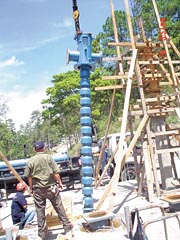
In the heart of mountainous western Honduras, the city of Santa Rose de Copan sits 3,900 feet above sea level and a half a mile above the Higuito River. Its high elevation makes every day feel like spring, and for centuries Santa Rosa residents depended solely on year-round spring-like rains to replenish their wells.
But when droughts blanketed much of Central America over the past few years, Santa Rosa found itself high and dry. With wells losing water levels at alarming rates, the city began rationing its water supplies. Some neighborhoods received water just once every five days, and the 25,000 residents started looking longingly at the river below wondering how they could get to its water.
The answer: bring the river to the city. Through a remarkable engineering feat - envisioned by USAID, designed by Hazen and Sawyer and its local associate Saybe y Asociados, engineered by Bomohsa and made possible by ITT Industries Goulds Pumps vertical turbine pumps manufactured in Lubbock, Texas - water soon will be flowing up the mountain to Santa Rosa.
It began when the humanitarian organization USAID agreed to fund a pump-and-piping project and identified Hazen and Sawyer as the design company. Hazen and Sawyer contracted with Bomohsa, a well-established Goulds Pumps vertical turbine pump distributor in Honduras, which immediately made two suggestions that would ensure project success.
“First, we suggested that the project have three pump stations - not just two - to boost the water uphill and deliver it into the town's water tank,” says George Faraj, general manager. “Then we insisted that they use ITT Industries' Goulds Pumps vertical turbine pumps at each station because they are efficient and can be integrated into the piping, which saves costs. I truly believe these recommendations saved the project from failure.”
USAID engineers began construction on the water delivery system. First, they located a spot 5 miles downriver where an infiltration gallery could be built into the riverbank. The water flows naturally into the collection area, runs through a sophisticated filtration system and then is propelled by three sets of powerful ITT vertical turbine pumps on its 6-mile journey - 51⁄2 miles horizontally and another half mile vertically.
The climb nearly killed the project. “When you are pumping water up, there always is the danger of creating a 'water hammer' when it meets the water coming back down,” explains Carlos Restrepo, ITT's territory manager for Central America and northern South America, who provided technical support and field support. “In this case, because we were dealing with such high pressures produced by our pumps to push the water up the mountain, the water hammer explosions were tremendous and the project suffered many pipe failures during the testing period.”
The project engineers solved the problem with the installation of special flow sensors and pressure transducers. With these modifications, the pumps and pipes passed all further tests, and now all that's left is the final pipe connection to Santa Rosa's distribution tank. When the system is fully operational, it will provide 1,600 gallons-per-minute of water to the parched town of Santa Rosa.
“With this system, the town of Santa Rosa should never suffer water shortages again,” says Faraj.
How important is this project to the townspeople? When the first tests were a success, one Santa Rosa engineer went on the city-wide radio station to let everyone know that “The Rio Higuito project is alive!” The president of Honduras plans to attend the inauguration ceremony, and one local cattle rancher promised to donate two cattle for the inauguration feast. At the celebration, there will be wine and beer to wash down the beef, but the sweetest drink of all will be the clean water flowing freely and powerfully from the town's taps.
ND
Report Abusive Comment